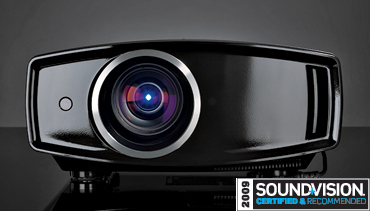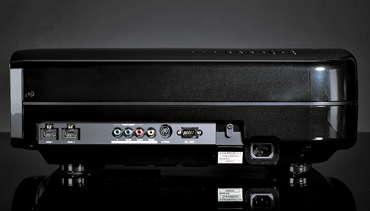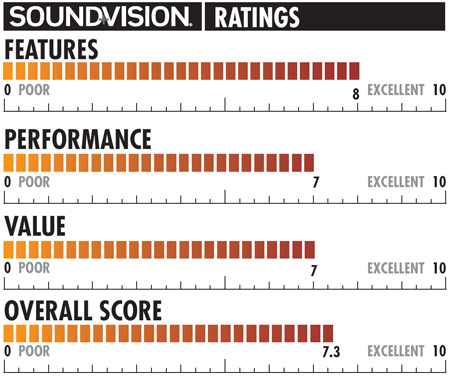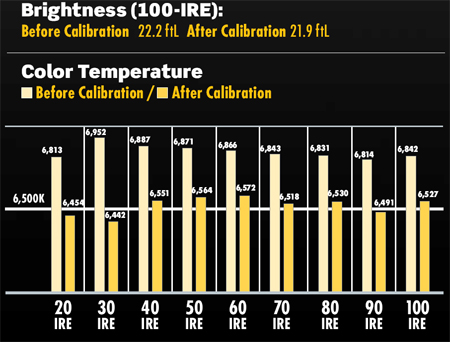New Projectors: Epson vs. JVC vs. Optoma Page 3

Key Features |
| $4,999 jvc.com |
| • 200-watt UHP lamp • 1080p resolution • 2x zoom lens • 120-Hz Clear Motion Drive • Motorized zoom, focus, and lens shift • Vertical-stretch mode for use with optional anamorphic lens • Inputs: 2 HDMI, component-, composite-, and S-video; RS-232C • Dimensions + Weight 65?8 x 143?8 x 187?8 in; 24.3 lb Price |
JVC DLA-HD550 LCoS Front Projector
JVC projectors have earned a rep for having the best native contrast in the industry. The DLA-HD750 is our Product of the Year for 2009 mostly because of its extraordinary contrast, achieved without the crutch of an auto iris. This year's models add JVC's 120-Hz Clear Motion Drive to reduce motion blurring, as well as a new screen-adjustment mode that compensates if your projection screen shifts the image toward red, green, or blue.
In the company of the Epson and Optoma projectors reviewed here, JVC's DLAHD550 feels like a Mercedes in a parking lot full of Toyotas. Everything is motorized: horizontal and vertical lens shift, zoom, focus, even the automatic lens cover. The DLA-HD550 also looks the sleekest. It uses the same Reon-VX video processor as the Epson ProCinema 9500 UB, and its 200-watt lamp is rated for 3,000 hours.
When it comes to the basics, such as image centering and focus, the DLAHD550 beats the competition by a mile. Its motorized image shift and zoom adjustments make it easy to get the image perfectly positioned on the screen. Best of all, its motorized focus lets you stand right next to the screen while making adjustments; you can fine-tune it until the edges of each pixel look as sharp as knife.
The DLA-HD550 fought me when I tried calibrating it. In the Cinema 2 mode, which is supposed to be set to the industry-standard color temperature of 6,500 K, the DLA-HD550 measured an average of 6,858 K. That's not bad, but I knew the projector could do better. Because the Cinema 2 mode didn't allow color temperature tweaking, I had to start from the User 1 mode. The somewhat unnatural response of the red and blue gain and bias controls made calibrating this projector a bit of a chore; it took about 45 minutes to get the color right. But for my effort I earned an excellent result: an average temperature of 6,517 K with a maximum deviation of 75 K.

However, the SMPTE color points for red, green, and blue weren't terribly accurate, and the DLA-HD550's consumeraccessible menus provided no adjustments. I can't say I was bothered by the look of the colors, but the purist in me can't ignore the fact that all of the projectors I've recently tested did better in this area.
JVC cites a contrast ratio of 30,000:1. Before calibration, I measured a very impressive 14,773:1; bringing the brightness and contrast controls to reasonable levels produced a still good 4,384:1. It was immediately obvious that the DLAHD550' s ability to reproduce deep black is in a whole other class than what I've seen from any other $5,000 projector.
Clear Motion Drive offers three settings: Off , Soft, and Strong. It seemed to work exactly like the Epson 9500 UB's frame interpolation did - it didn't improve the look of 24-fps material, but it nicely smoothed the motion on the 1080i video material from the Ultimate Fighting Championship: Best of 2008 Blu-ray Disc. Both the soft and strong settings looked great; I chose strong because, as with the 9500 UB's frame interpolation, I saw no downsides to Clear Motion Drive.
(Incidentally, no screen that I've ever used has enough color shift to make the DLA-HD550's screen-adjustment mode useful, but I suppose it could help if you're projecting the picture on an off-white wall.)

In general, the DLA-HD550 delivers an extraordinarily dynamic, punchy picture. Contrast and detail are awesome, especially considering the projector's price. The only projectors I've tested that can match the DLA-HD550's deep blacks are the DLA-HD750 and Sony's VPLVW70, both of which cost $3,000 more when they were introduced. Terminator Salvation's intricately constructed visuals - weaving CGI, crane shots, and handheld shots into seamless, nonstop action scenes - seemed even more dramatic than with the Epson projector, especially in the high-contrast opening battle scene.
The DLA-HD550's picture did have one characteristic that wasn't to my taste: The blacks sometimes looked a little too black, leaving the dark areas and shadows with little detail. In the shot from Terminator Salvation where John Connor slides down a rope into a cavern, I could see little but the actor and the light he was holding. I got a better look on this disc by going into the custom gamma mode and selecting a 2.0 gamma setting, but most movies looked best at the default 2.2 setting.
Overall, I slightly preferred the picture and the less fussy setup of the Epson 9500 UB. But I suspect a lot of people - including some, and maybe most, of my reviewer pals - would prefer the JVC's picture. If you want a purer picture with a simpler setup, I'd go with the Epson. If you want something more dramatic - and if you really love deep, dark black levels - go with the JVC.

Test Bench
Primary Color Point Accuracy vs. SMPTE HD Standard
Color | Target X | Measured X | Target Y | Measured Y |
| Red | 0.64 | 0.67 | 0.33 | 0.33 |
| Green | 0.30 | 0.28 | 0.60 | 0.70 |
| Blue | 0.15 | 0.15 | 0.06 | 0.04 |
The DLA-HD550's Cinema 2 picture preset delivered the best out-of-the-box picture. Average color temperature measured 6,858 K from 30 to 100 IRE. Switching to the User 1 mode and the Custom 1 color temperature setting, I was able to achieve an average color temperature of 6,517 K with maximum deviation of 75 degrees.
Color decoder tests through the HDMI and component-video inputs delivered almost perfect results. Through HDMI, red was 5% low while blue and green were dead on. There was no error at all through the component-video input. However, the set's red, green, and blue primary color points were a ways off from the SMPTE HD specification for digital TV colors. The projector's consumer menu offered no opportunity to adjust these.
I expeimented with several adjustable iris settings, settling on 3. The projector has two lamp brightness modes: Normal and High. I got plenty of brightness out of the Normal mode, which measured 21.9 fL when projecting a 78-inch-wide image on my Stewart StudioTek 100 screen in the User 1 mode after adjustment of the brightness and contrast controls. Native contrast ratio measured an impressive 14,773:1 in Cinema 2 mode at factory settings, and 4,384:1 after calibration. In High lamp mode, max luminance increased to 32.1 fL while maintaining a very respectable 3,563:1 contrast ratio.
The DLA-HD550 offers several gamma presets: Normal, A, B, C, and D. The extensive gamma adjustment offers loads of options, including gamma settings from 1.8 to 2.6; adjustment of the white/gray/black gamma in 10 IRE steps; and separate adjustment of gamma for red, green, and blue.
Overscan measured 0% with the overscan function deactivated, and 2% with overscan activated on 480i signals through the component input. (Overscan can't be selected on HD or PC signals.) The projector displayed 1080i/p and 720p test patterns with full resolution through both the HDMI and component video connections. Brightness and color uniformity were nearly perfect whether the image was bright, dark, or in-between. A crosshatch pattern showed a minor vertical convergence error on green, at the right side of the image, but the position controls affect only the entire image, not a particular zone, so there was no way to correct this problem.
The projector showed no "jaggies" or resolution loss on when I played film or video test patterns from the DVD and Blu-ray versions of the Silicon Optix HQV Benchmark disc. It deinterlaced 1080i beautifully whether the original source was film or video. However, the 480i deinterlacing test pattern from the DVD showed the projector's recognition of 2:3 pulldown in 480i is rather slow, so you might occasionally notice artifacts with 480i material. The projector's noise reduction offers extensive adjustments, including overall noise reduction, mosquito noise reduction, and an on/off setting for block noise reduction - a capable, if rather confusing, control array. However, the noise reduction is only effective on 480i signals. There is no noise reduction for HD signals.
The fan noise is quite low-probably not the quietest I've heard, but close enough.




























































